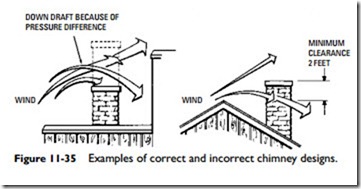Chimney
Most chimneys are constructed of brick or metal. If a brick chimney is used, it should be lined with a protective material to prevent damage from water vapor. The most commonly used liner is smooth faced tile. Prefabricated factory-built chimneys are also used, but only those listed by Underwriters Laboratories are suit- able for use with fuel-burning equipment.
The standard chimney must be at least 3 ft higher than the roof or 2 ft higher than any portion of the structure within 10 ft of the chimney flashing in order to avoid downdrafts (Figure 11-35).
An existing chimney should always be checked to make sure it is smoketight and clean. Any dirt or debris must be cleaned out before the furnace or boiler is used. See Chapter 3, “Fireplaces, Stoves, and Chimneys” in Volume 3 for additional information about chimney construction, maintenance, and repair.
Caution
If an original furnace has been replaced by a mid-efficiency or high-efficiency furnace, the chimney cannot be used to vent the combustion gases unless it has been rebuilt or modified. The cooler gases of these more efficient furnaces lack the buoyancy of those produced in the conventional standing-pilot furnaces. Consequently, they do not rise quickly up the chimney. The condensate of these cool, slower moving gases will collect on the chimney walls and eventually destroy the masonry.
